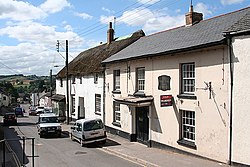Bow, Devon
- Not to be confused with Bow, Ashprington
| Bow | |
| Devon | |
|---|---|
 Bow, Devon | |
| Location | |
| Grid reference: | SS722017 |
| Location: | 50°48’4"N, 3°48’53"W |
| Data | |
| Postcode: | EX17 |
| Local Government | |
| Council: | Mid Devon |
Bow is a village in Devon, in the midst of the county, about eight miles west of Crediton. The 2001 census recorded a population of 1,093. Its name to an arched bridge on the River Yeo here.
The adjoining hamlet, Nymet Tracey, shares a church with Bow and much common history.
History
West of the village are the remains of a 'woodhenge' from the 3rd millennium BC, which has been named 'Bow Henge'. Its 19 post holes were discovered by aerial photography in 1984.[1][2]
The A3072 road which runs through the village is almost certainly a Roman road, although not the first in the area. The first was south of the village, and runs from the Roman fort at North Tawton to Isca Dumnoniorum (Exeter).
The main settlement was originally at Nymet Tracey, a mile south of Bow's present location. It is mentioned in the Domesday Book of 1086.
The parish church is still in Nymet Tracey. It is dedicated to St Bartholomew (a dedication recorded from 1742, though it might have previously been dedicated to St Mary, or St Martin).[3]

Bow itself is a creation of the thirteenth century. In 1258-59 Henry de Tracey was granted charters for a weekly market and a three-day annual fair starting on St Martin's Day. The market was held on the main Crediton to Okehampton road (now the A3072), and the village, Bow, grew up at the market location.
King Charles I stayed one night in Bow during the Civil War when he was chasing the Earl of Essex into Cornwall.
Bow, due to its location, failed to attract enough trade to justify its status as a town and remained a street village or one of Devon's many "failed towns".[1][4] The market ceased in 1792. The mother village, Nymet Tracey, had about sixty to eight cottages as the nineteenth century opened, but was destroyed by two fires in 1833 and in 1835, after which the bulk of the population moved to Bow. The influx of people did not halt its decline, and by 1850 Bow was described as a "small, decayed market town";[5] the St Martin's Day fair, first recorded in 1259,[3] ceased about1900.
In the late 19th and early 20th centuries Bow was spiritually divided between the Church of England, the Congregationalists and the Plymouth Brethren. A local lady, Griffiths, Grace, wrote a book describing village life in the vigorous spiritual time of the 1920s.[6]
There was a railway station here, but Bow Station, like so many others, fell victim to the Beeching Axe in the early 1970s.
In recent years Bow has expanded considerably to the south. Bow has a caravan park, a general store and a garden centre with café, a doctor's surgery and one public house.
Churches

- Church of England: St Bartholomew's, in Nymet Tracey
- Congregational Church
- Gospel Hall (Open Brethren)
Outside links
| ("Wikimedia Commons" has material about Bow, Devon) |
- Historic Bow, DCC includes 1765 map
- Information on Bow, Devon from GENUKI
- Bow in 1986 BBC Domesday project
- Large 30mph speed signs painted on house in Bow, Devon BBC News, 23-Nov-2011
References
- ↑ 1.0 1.1 Toulson, Shirley: 'The Companion Guide to Devon', ISBN 0-00-215135-9
- ↑ Megalithic Portal: Bow Henge
- ↑ 3.0 3.1 Orme, Nicholas: 'English Church Dedications' (University of Exeter Press, 1996) page 188 ISBN 0-85989-516-5
- ↑ W.G. Hoskins, Devon and its people, Wheaton, Exeter, 1959
- ↑ White's Devonshire Directory (1850)
- ↑ Griffiths, Grace: 'My Days of Freedom' ISBN|0-437-06500-6